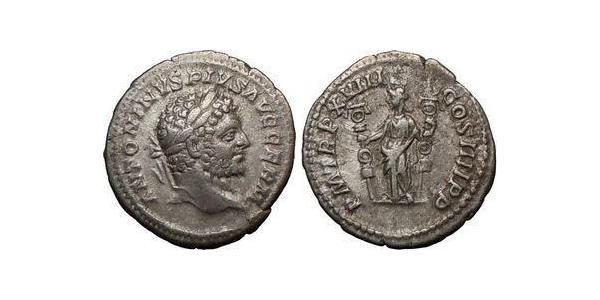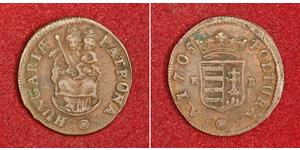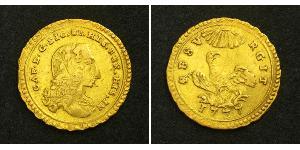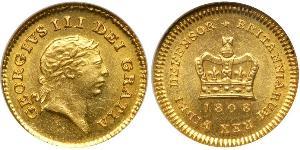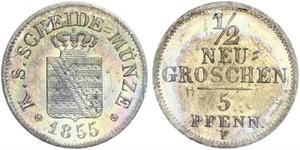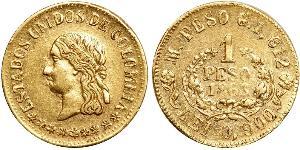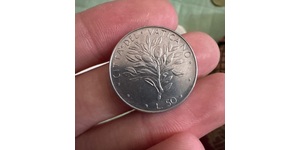[ 2373] CARACALLA, 211-217 A.D. Silver Denarius (19mm, 3.02 gm), Rome, 215 A.D. Reference: RIC 266, BMC 143, S 6840, C 315 ANTONINVS PIVS AVG GERM - Laureate head right. PM TR P XVIII COS IIII PP - Fides, the Goddess of trust, standing left, holding standard in each hand. Provided with certificate of authenticity. CERTIFIED AUTHENTIC by Sergey Nechayev, PhD - Numismatic Expert In Roman mythology, Fides ("trust") was the goddess of trust. Her Greek equivalent was Pistis. Her temple on the Capitol was where the Roman Senate kept state treaties with foreign countries, where Fides protected them. She was also worshipped under the name Fides Publica Populi Romani ("trust towards the Roman state"). She is represented by a young woman crowned with an olive branch, with a cup or turtle, or a military ensign in hand. She wears a white veil or stola; her priests wear white. Rome's second king, Numa Pompilius instituted a yearly festival to Fides, and directed the priests to be borne to Her temple in an arched chariot drawn by two horses and should conduct Her services with their hands wrapped up to indicate protection. Antoninus (Called 'Caracalla') Caesar: 195-198 A.D. Augustus: 198-217 A.D. ( 198-209 A.D. - with Septimius Severus) ( 209-211 A.D. - with Septimius Severus and Geta) ( 211-217 A.D. - Sole Reign)Caracalla (April 4, 188 – April 8, 217. Caracallus ), born Lucius Septimius Bassianus and later called Marcus Aurelius Antoninus and Marcus Aurelius Severus Antoninus, was the eldest son of Septimius Severus and Roman Emperor from 211 to 217. He was one of the most nefarious of Roman emperors. Caracalla's reign was notable for: the Constitutio Antoniniana, granting Roman citizenship to freemen throughout the Roman Empire, according to Cassius Dio in order to increase taxation; debasing the silver content in Roman coinage by 25 percent in order to pay the legions; and the construction of a large thermae outside Rome, the remains of which, known as the Baths of Caracalla, can still be seen today "Caracalla was the common enemy of all mankind," wrote Edward Gibbon. He spent his reign traveling from province to province so that each could experience his "rapine and cruelty." Caracalla's real name was Marcus Aurelius Antoninus. He got the nickname from his habit of wearing a cloak by the same name. Caracalla was the elder son of Septimius Severus and brother of Geta whom he positively hated. Hated so much, in fact, that he had him murdered a few years later. In the mayhem that followed, Caracalla's men went on a killing spree of anyone suspected of being a Geta sympathizer. In the massacre, it's estimated up to 20,000 people lost their lives. Caracalla would go on to rule for another five years but his bad karma caught up with him and he was assassinated in a plot perpetrated by Macrinus. As an emperor Caracalla possessed few redeeming qualities and among the worst of them would be his ruinous drain on the treasury. Because he knew everyone hated him he sought the protection of the army. And the surest way of getting this protection was to buy it outright. He raised the pay of the solider to about four denarii per day, nearly quadrupling the salary of just a few years prior. And on top of their regular salary he heaped endless bonuses and other concessions meant to endear them. This money could only have come by the oppressive taxation of ordinary citizens as well as the seizures of property of the wealthy under trumped-up charges. This not only intensified the hatred against him but also had the effect of corrupting the military who had become accustomed to this life of luxury and throwing the economy into lasting disarray. Payment & Shipping: Will accept payments via PayPal. = MM_contentVersion;
}
else if (navigator.userAgent && navigator.userAgent.indexOf("MSIE")>=0 && (navigator.appVersion.indexOf("Win") != -1)) {
document.write('\n');
document.write('on error resume n ...
type to read more

|
Posted by:
anonymous 2015-08-19 |
Similar Coin Groups
2025-06-04
- Live Coin Catalog's improvements / coins uploading
27 coins were uploaded from 2025-05-28 to 2025-06-04
One of them is:
2025-05-23
-
New coins
New coins from
Save seller - lne.inc
.
One of them is
One of them is
Germany Bavaria 1778 H.ST - Silver Thaler - KM# 562 - DAV# 1963
You may be interested in ...

